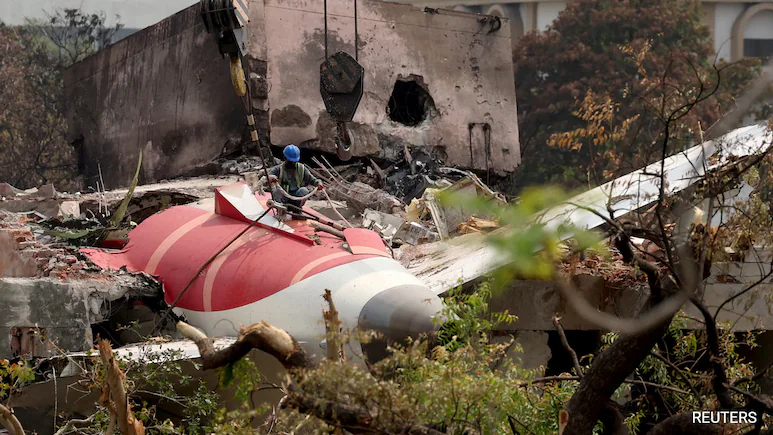Recent Air India Crash: Black Box Recovery and Investigation Progress
– In a significant development following the tragic crash of an Air India flight in Ahmedabad earlier this month, Civil Aviation Minister K. Rammohan Naidu declared on Tuesday that the black box from the ill-fated aircraft is currently under examination by the Aircraft Accident Investigation Bureau (AAIB). This announcement came as he sought to quell rumors that the crucial device might be sent abroad for further analysis. The black box, a crucial tool in understanding aviation accidents, holds vital data regarding the flight’s operations and is expected to provide key insights into the circumstances surrounding the crash.
The accident occurred shortly after the Air India flight took off from the Sardar Vallabhbhai Patel International Airport in Ahmedabad on June 12. The Boeing 787-8 Dreamliner tragically crashed into a nearby hostel complex, leading to the loss of 270 lives, with 241 individuals on board the aircraft. Remarkably, only one passenger survived the catastrophic incident. This unfortunate event has raised numerous questions about aviation safety and protocols, especially considering the high number of fatalities.
As part of the ongoing investigation, the black box, which was recovered from the crash site on June 13, plays an essential role in piecing together the events leading up to the crash. “A black box is not merely a recording device but a key to understanding what transpired during the flight,” said Minister Naidu. The data retrieved from the black box will be instrumental in determining the causes of the crash and analyzing the aircraft’s performance leading up to the incident.
The Investigation Process: Understanding Aviation Safety and Accountability
The investigation is being spearheaded by a high-level panel set up by the government, focusing on various factors that could have contributed to the crash. Minister Naidu emphasized the importance of allowing the AAIB to conduct its thorough examination without interference. “Let the AAIB conduct the probe and go through the entire process,” he asserted, highlighting the need for a meticulous approach in such critical investigations.
Questions about the timeline for retrieving data from the black box were raised during the minister’s address. While he noted that the process is highly technical and dependent on numerous factors, he did not provide a specific timeframe. The complexities involved in decoding the data are significant but vital, as they will yield insights into the plane’s mechanical performance and pilot communications close to the time of the crash.
As per the report by[NDTV](https://www.ndtv.com/india-news), Minister Naidu expressed optimism about the investigation’s progress, indicating that the information gathered would allow for a comprehensive understanding of the circumstances surrounding the incident. “Decoding the black box is going to give an in-depth insight into what happened moments before the plane crash,” he remarked, suggesting that the investigation team is making headway in their efforts.
The tragic crash of the Air India flight not only raises serious questions regarding aviation safety protocols but also reflects the need for continuous improvements in emergency response mechanisms in the aviation industry. With increasing air traffic numbers, this incident underlines the critical importance of thorough investigations and remedial measures to prevent similar tragedies in the future.
Aviation Safety and Future Measures
Following the crash, the government has also initiated discussions surrounding aviation safety measures. The incident has prompted a broader dialogue about ensuring that air travel remains safe, particularly in regions prone to adverse weather or infrastructural challenges. Recognizing the complexity inherent in modern aviation, stakeholders from various sectors, including government agencies and private airline operators, are expected to collaborate closely to develop and refine safety protocols.
The Helicopters & Small Aircraft Summit 2025, organized by the Federation of Indian Chambers of Commerce & Industry (FICCI) in partnership with the Ministry of Civil Aviation, provided a platform for such discussions. Minister Naidu’s participation underscored the government’s commitment to engaging with industry leaders to better understand the challenges faced in maintaining safety standards.
Air travel safety is a shared responsibility, and recent incidents highlight the importance of collaboration between regulatory bodies, airlines, and airports in fostering a culture of safety. The focus must be on implementing advanced technology for monitoring aircraft systems, improving training for pilots and crew, and ensuring rigorous maintenance protocols.
Moving Forward: The Role of Technology in Aviation Safety
As the investigation into the Air India crash unfolds, the role of technology in enhancing aviation safety cannot be overstated. Innovations in flight tracking, real-time monitoring systems, and advanced simulation training programs have the potential to significantly reduce the likelihood of accidents. The information gleaned from the black box can lead to the identification of specific technical failures or human errors, fostering a learning environment for the aviation industry.
The resilience shown by the sole survivor of the crash also serves as a reminder of the human element involved in aviation safety. Their experience may help investigators understand other facets of the incident, including cabin safety protocols and passenger preparedness for emergencies.
Moving forward, collaboration between regulatory authorities, aviation professionals, and technology developers is paramount. By leveraging data-driven insights from incidents and utilizing advanced technologies, the aviation sector can take proactive steps to mitigate risks and enhance safety for all passengers.
While the investigation into the Air India crash continues, the efforts put forth by the AAIB and the broader aviation community will be instrumental in shaping the future of air travel in India and beyond.
For more information on aviation safety standards and regulations, visit the[International Civil Aviation Organization (ICAO)](https://www.icao.int) or read about the[latest developments in aircraft technology](https://www.airbus.com).
DISCLAIMER
We have taken every measure to ensure that the information in this article and on our social media platforms is accurate, verified, and obtained from reliable sources. For feedback or complaints, please contact us at info@hamslive.com.


